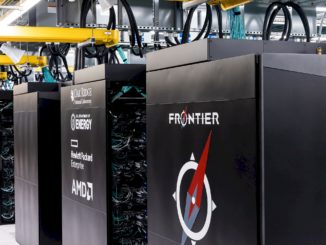
Under two unrelated US Department of Defense procurements, Cray has been awarded a total of $71 million to supply the Air Force and Army with a trio of HPC systems. The contracts include a “Shasta” supercomputer to be used by the Air Force Life Cycle Management Center, and a pair of CS500 systems destined for Army centers managed by High Performance Computing Modernization Program (HPCMP). All three machines will be equipped with AMD’s brand spanking new “Rome” Epyc processors.
The Shasta system, known as HPC11, will be used by the Air Force Life Cycle Management Center, more specifically, the Air Force 557th Weather Wing, to provide operational weather forecasting and meteorology for both the Air Force and Army. In particular, the machine will be used to run the latest high-resolution, global and regional weather models, which will be used to support weather forecasts for warfighters, as well as for environmental impacts related to operations planning.
As Cray likes to point out, 85 percent of the world’s weather centers use Cray supercomputers to provide their forecasts. And although the HPC11 is just another data point to back up that statistic, it is the first AMD-powered Shasta system in this category.
According to Steven Wert, program executive officer digital at the Air Force Life Cycle Management Center at Hanscom Air Force Base in Massachusetts, the new supercomputer will offer a “significant increase in performance” compared to their existing capability. The center currently relies on “Thor,” a 902 teraflops Intel Xeon cluster that was installed in May 2016. That system could provide forecasts for areas as small as 17 square kilometers. Prior to that, the Army and Air Force relied on weather forecasting support from the United Kingdom’s Met Office.
The new HPC11 machine will be comprised of eight Shasta cabinets and will be powered exclusively by AMD Rome processors. It is to be hosted by Oak Ridge National Laboratory , which will supply the machine as a supercomputing service to the Air Force 557th Weather Wing. The contract value for the system and its support is valued at $25 million. It is slated for delivery in the fourth quarter of 2019, with acceptance sometime in early 2020.
The DoD is also buying two Cray CS500 systems under a separate HPCMP contracts valued at more than $46 million. One machine will go to the Army Research Lab (ARL) at the Aberdeen Proving Ground, Maryland, and the other to the Army Engineering and Research Development Center (ERDC) at Vicksburg, Mississippi. These are to be used to support scientific and engineering research undertaken at the two centers.
Cray has done business with the High-Performance Computing Modernization Program before, but it has also bought systems from Hewlett Packard Enterprise, IBM, and prior to its acquisition by HPE, SGI. The last major procurement was back in 2018, when HPCMP acquired seven HPE SGI 8600 supercomputers for two sites: four systems for the Air Force Research Laboratory and three for the Navy’s Stennis Space Center.
The ARL system will be comprised of 102,400 Epyc Rome compute cores plus 292 Nvidia Volta V100 GPUs. Storage will be supplied by 350 TB of NVM-Express flash, backed by 11 PB of disk storage. The ERDC machine is computationally less intense, with 80,320 Epyc cores and just 16 V100 GPUs. Storage is distributed a little differently as well, with 30 TB of NVM-Express flash and 15 PB of disk capacity. Together, the two CS500 systems provide 10.6 petaflops of peak performance, which will bump the aggregate capacity of the HPCMP supercomputing to 57 petaflops.
Like the Shasta machine for the Air Force, the two Army systems are expected to be installed in the fourth quarter of 2019 and go into production in early 2020.
Now that HPE is in the process of the acquiring Cray, it will likely end up splitting future HPCMP procurements between just itself and IBM. Although HPCMP doesn’t buy the kind of $500 million supercomputers that the US Department of Energy does, it does upgrade its smaller system a good deal more frequently, usually every couple of years. Given that these contracts usually run between $25 and $50 million, that’s a nice chunk of change that HPE can count on.
While all of this is certainly good news for Cray and HPE, the more significant story is AMD’s newfound ability to chip away at Intel’s server stranglehold and re-establish itself as a force to be reckoned with – not just in HPC, but in the enterprise and cloud as well.
With Rome, the company appears to have its first CPU in more than a decade that can go head-to-head with Intel’s best in all segments of the server market. The fact that conservative buyers like the DoD are comfortable buying HPC machinery with boatloads of AMD CPUs says a lot about how the market now perceives the chipmaker. We fully expect to see more such announcements in the coming year.





re: “that can go head-to-head with Intel’s best”
I would have stated a 1.5+x performance, performance/watt and performance/$ advantage differently!